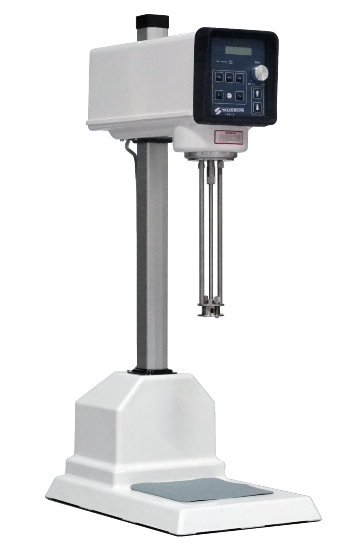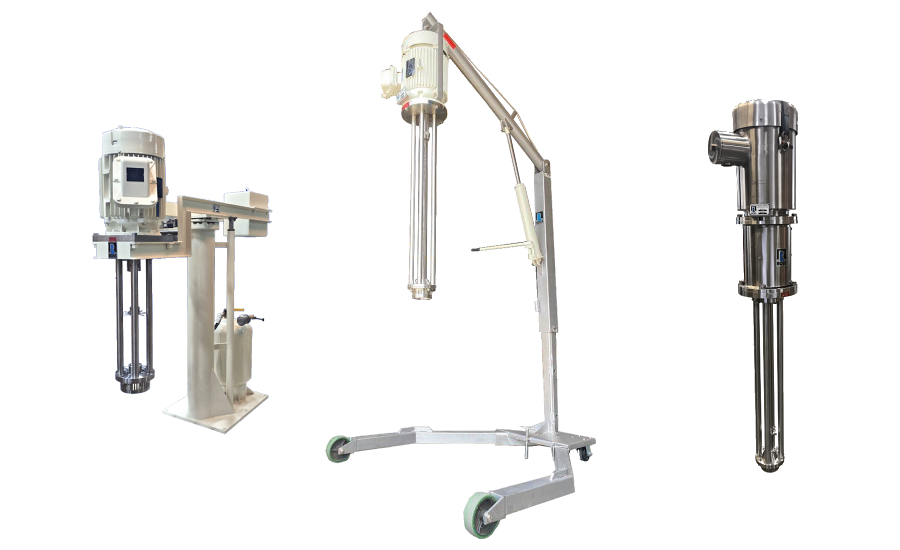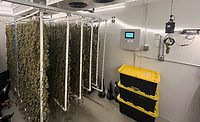Using mixers to support cannabis food and beverage manufacturing
Mixing equipment suppliers talk shear, other manufacturing considerations.

Photo from Silverson.
Precise doses are critical for delivering safe and effective cannabis foods and beverages, and achieving formulation homogeneity is the first step in hitting piece and package potency levels.
Mixing equipment plays a key role in this process, helping manufacturers incorporate cannabis oils into their infused products.
Cannabis Products Insider recently spoke to Matt Smith, sales director, Silverson Machines, and Erin Dillon, media and marketing coordinator, Charles Ross & Son Company, about their companies’ cannabis experience, the importance of shear, and other crucial mixing and manufacturing considerations.
CPI: How would you describe your company’s experience in working with cannabis customers?
MS: We’ve provided mixing solutions to hundreds of customers in the U.S. and around the world so far, mostly for small-scale and R&D-scale projects in the food and cosmetics industries. These customers are producing cannabis-infused products such as beverages, gummies, oils and creams.
ED: ROSS has decades of experience working with a wide range of industries, including pharmaceuticals, nutraceuticals, food and beverage, personal care and cosmetics. Our team has developed a strong understanding of the needs and requirements of each of these industries, and we have leveraged this knowledge and applied it to cannabis product manufacturing. We can offer unique insights and solutions to help cannabis manufacturers produce high-quality and highly repeatable cannabis-infused products.
CPI: What exactly is shear? Why is it important for manufacturers of cannabis products?
ED: Shear is a term used to describe the force applied to materials when they are subjected to mixing or blending. In the context of cannabis products, shear is essential to achieving the correct dosage, bioavailability, appearance, flavor, texture and stability or shelf life of various products, including infused oils, lotions, balms, ointments, creams, beverages and tinctures.
The ROSS High Shear Mixer is comprised of a rotor that turns at high speed within a stationary stator. As the blade rotates, materials are continuously drawn into one end of the mixing head and expelled at high velocity through the openings of the stator. The hydraulic shear generated promotes fast mixing, breaks down agglomerates and reduces the size of droplets.
In a stable emulsion, the dispersed phase is suspended uniformly as droplets throughout the continuous phase, with the two phases being immiscible with each other. The size distribution of these droplets is critical, as it affects both stability and viscosity. By using a high shear mixer, cannabis manufacturers can achieve a stable emulsion with a uniform droplet size distribution, leading to better stability and a longer shelf life for their products.
MS: In mixing terms, shear force relates to liquid flowing at different speeds within a container. With a conventional agitator, the liquid tends to swirl around at a relatively similar speed, so this is considered a low shear device. A rotor stator mixer imparts high shear into a mixture as liquid and solid materials are sucked into the workhead, subjected to a milling action in the precision gap between the rotor stator (mechanical shear), then forced out through the holes in the stator and projected back into the body of the mix at high velocity (hydraulic shear) – the difference in velocity of the flow between the two bodies of liquid is why this is called high shear mixing.
This is most relevant in the production of CBD oil-based products where high viscosity CBD oil is being blended with low viscosity liquids. With a conventional agitator, the higher viscosity liquid tends to form globules which don’t readily blend with the lower viscosity liquid – this is called “stratification” because often layers of unmixed liquids form. With a rotor stator mixer, the positive mixing which draws the two liquids through the high shear workhead combines them almost instantaneously.
This mixing also allows a high shear mixer to be used for all kinds of mixing processes such as forming emulsions, particle disintegration, powder/liquid mixing and blending liquid of various viscosities, to name a few.
CPI: Beyond shear, what factors should manufacturers consider when they’re looking to purchase a mixer? How do size/capacity and the ability to scale up play into this?
MS: Batch size and the ability to scale up need to be considered, especially where potency levels need to be maintained, preferably before product development starts. If you create a product using a laboratory mixer that does not have a production scale equivalent, the product formulation process might need to be restarted to achieve the same results at a larger scale. All Silverson mixers are built to the same fine tolerances and a common workhead geometry, so a product created in the laboratory can be easily scaled up to the larger Silverson production mixers without the need to reformulate.
Other factors to consider when purchasing a mixer are whether the mixer will be used to create more than one product or carry out more than one mixing task. Thanks to the range of easily interchangeable workheads, high shear mixers can perform a wide range of mixing tasks, such as blending, disintegrating, dissolving, emulsifying and homogenizing. In the past, this may have required several different pieces of process equipment, so a rotor stator space can also improve productivity and eliminate the need for additional capital equipment. In-tank mixers can also be used on mobile floor stands, making them easy to move from vessel to vessel when processing multiple products.
ED: One simple but often overlooked consideration is proper mixer selection. Most products can be made with several styles of mixers and through a variety of manufacturing methods. Different mixing equipment and manufacturing methods can have a significant impact on the quality, consistency and efficiency of the end product. Working with a trusted OEM like ROSS is important when selecting a mixer. We can offer the necessary guidance and support to ensure that the mixer is optimized for the specialized requirements of the cannabis industry.
When it comes to growing demand, manufacturers should not only consider their current needs but also anticipate future growth and scaling requirements. Choosing a mixer with the ability to scale up can save time and money by avoiding the need to purchase additional equipment as production increases. In some cases, semi-continuous mixing can be a more efficient strategy than simply adding more mixers. With interchangeable multiple vessels and a single mixer, one vessel can be at the loading stage, another under the mixer, another at the discharge step and another at the clean-up stage. This approach maximizes both the production floor and labor utilization, the result is improved efficiency, reduced downtime and cost savings. With the right mixer and expert support, manufacturers can maximize their productivity, product quality and profitability.
CPI: How can mixing equipment help manufacturers develop cannabis emulsions? Does it vary by application?
ED: Mixing equipment can play a critical role in developing cannabis emulsions, as it enables the reduction of particle size, droplet distribution, and stability required for optimal performance and shelf life. However, the specific mixing equipment needed can vary based on the application and product requirements. For example, the ROSS High Shear Mixer is ideal for emulsions under 10,000 centipoise (cP). They can effectively break down agglomerates and reduce droplet sizes, ensuring uniform droplet distribution in the emulsion. Multi-shaft mixers equipped with two or more independently-driven agitators can efficiently handle viscosity changes well over 100,000 cP. This versatile machine delivers a combination of high shear agitation and laminar bulk flow, making it ideal for batching thicker emulsions like lotions and creams.
Working with a trusted manufacturer like ROSS, with a wealth of experience and a well-equipped testing and development center, can help cannabis manufacturers identify the most efficient and effective mixing equipment for their specific needs.
MS: When creating emulsions, the type of mixing equipment is vital to the stability of the emulsion. The key to creating a stable emulsion is obtaining the finest possible droplet size. The more shear energy introduced into the mix, the smaller the suspended droplets will become, creating a fine stable emulsion. Although agitators can give satisfactory results for simple duties such as blending like-viscosity liquids, they cannot form a uniform, stable emulsion as no shear energy is imparted into the mixture — the globule size of each phase cannot be sufficiently reduced to maintain stability. Although the phases may appear to have been mixed, once agitation is stopped the phases will separate.
Silverson mixers are ideally suited to this application and can easily achieve emulsions with a droplet size of 2 to 5 microns. Finer emulsions down to 0.5 microns can be obtained, depending on the formulation. In many cases, this can eliminate the need for high pressure homogenizers. This is true of all emulsions, water-in-oil or oil-in-water.
CPI: Are there particular mixer models that your customers in the cannabis space gravitate toward?
MS: Our laboratory mixers have been our most popular model for this industry. They come with a range of easily interchangeable workheads and can process batches of up to 20 liters, making them ideal for product development and R&D. For slightly larger volumes of up to 50 liters, our AX Pilot Scale models have been popular with those scaling up from laboratory models to expand their production lines and keep up with customer demand. Silverson in-tank batch mixers have been provided to customers wanting to scale up to even larger volumes.
 Silverson L5M-A Laboratory Mixer
Silverson L5M-A Laboratory Mixer
ED: When it comes to mixing equipment in the cannabis space, there are a few models that ROSS customers tend to gravitate towards depending on their specific needs. For cannabis-infused emulsions, high shear mixers and multi-shaft mixers are popular choices due to their ability to reduce particle size and create stable emulsions. However, there are also instances where dry blending is necessary in the production of cannabis products in powder or tablet form, or powders requiring minor liquid additions. In these cases, ROSS offers ribbon, vertical and tumble blenders.
 Ross Batch High Shear Mixers
Ross Batch High Shear Mixers
The Ribbon Blender is a U-shaped horizontal trough with an agitator made up of inner and outer helical ribbons that move material axially in opposite directions and radially with tip speeds of approximately 300 fpm. This style of blender is suitable for the straightforward, gentle mixing of dry ingredients. Minor liquid addition is best accomplished using spray nozzles installed in a spray bar located just above the grating.
 Ross Ribbon Blender
Ross Ribbon Blender
The Vertical Blender is characterized by a slow turning auger screw that orbits a conical vessel wall while it turns and gently lifts material upward. As materials reach the uppermost level of the batch, they cascade slowly back down in regions opposite the moving auger screw. This blender is suitable for more delicate applications and can also be used for vacuum drying.
The Tumble Blender is characterized by a rotating vessel that typically comes in a double-cone or V-shaped configuration. Materials cascade and intermix as the vessel slowly rotates. This blender is ideal for thoroughly mixing highly friable materials without compromising their integrity. It's notably used in the cannabis industry because of its ability to create precise blends that contain minor and trace components or ingredients that are vastly dissimilar in size and density.
CPI: Is there anything else you’d like to add?
MS: The batch-to-batch consistency achieved with a Silverson mixer is advantageous where declared CBD potency levels need to be maintained. There is lots of information in our application reports and how to videos available on the Silverson website.
This article was originally posted on www.cannabisproductsinsider.com
Looking for a reprint of this article?
From high-res PDFs to custom plaques, order your copy today!







